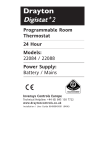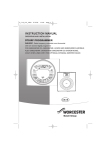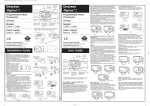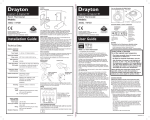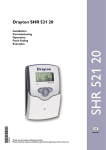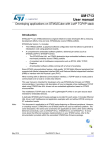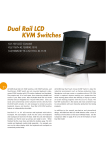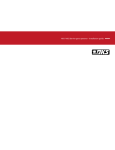Download Drayton 22192 Technical data
Transcript
Digistat+1 & Digistat+1RF Room Thermostat Models: RF710/22190/22192 Invensys Controls Europe Technical Helpline: +44 (0) 845 130 7722 www.draytoncontrols.co.uk )NSTALLATION 'UIDE 2& 02/$5#4 /.,9 ).34!,,!4)/. /& 3#2 2& -ODELS ONLY Digistat SCR On Receive / Alarm Override 2 1 Learn Mode Wireless System If you do not have the knowledge to install the SCR safely then you must arrange for a competent electrician to install it for you. Wiring must conform to the current IEE wiring regulations. Prior to commencing the installation you must ensure the mains supply is switched off. )NSTALLATION )NSTRUCTIONS 2EAD ALL INSTALLATION AND COMMISSIONING INSTRUCTIONS BEFORE PROCEEDING $O NOT SWITCH ON UNTIL READY TO COMMISSION The system wiring must be able to be fully disconnected from the mains supply by a switch incorporated in the fixed wiring having a contact separation of at least 3mm on both poles. Fused at 3A. ,OCATION The Digistat SCR (receiver) should be mounted in a convenient position, close to the boiler or central heating system wiring centre. (Care should be taken not to mount the SCR in a position where it is surrounded by metal objects or mains voltage cable, as this may interfere with the radio signal). For the best performance install in an open space, at least 30cm distance from any metal objects including wall boxes and boiler housing. It is recommended that the SCR is mounted on the wall nearest the final location of the Digistat +RF room thermostat and not less than 30cm from the boiler side panel. 7ARNING )NSTALLING THE 3#2 TOO CLOSE TO THE METAL SIDE PANEL OR MAINS CABLES MAY INTERFERE WITH THE RADIO SIGNAL 30cm Min BOILER SCR Radio Signal Range: 30m Typically The range may be affected by composition/density and number of walls between the Digistat +RF and SCR Preferred side of boiler &IXING MINIMUM WALL PLATE CLEARANCES SHOWN 1. Loosen the securing screws, remove the wallplate, and if surface wiring is to be used, snap out the cable entry strip on the bottom edge of the wallplate with a pair of pliers. 2. Fix the wallplate, terminals at the top, either direct onto the flat wall using wall plugs and no 6 x1” wood screws or on a flush mounting single conduit box using M3.5 x 14 screws. Minimum wallplate clearances are shown. 3. Complete the wiring to the SCR wallplate in accordance with the relevant diagram, to comply with current IEE wiring regulations. 4. Place the SCR onto the wallplate and tighten the securing screws. 3#2 WALLPLATE CLEARANCES 50 mm minimum clearance N L 1 2 3 4 40 mm minimum clearance 40 mm minimum clearance 70 mm minimum clearance %LECTRICAL Volt free contacts N 230V a.c. Fused 3A L 1 Common 2 3 Call for Heating heat satisfied or call for cooling This product is double insulated and does not require an earth connection. The SCR should be wired to the combi boiler or central heating wiring using the correct type of cable or flex. The SCR should be wired in to replace hard wired room or programmable thermostats shown on the system or boiler wiring diagrams. Always check other manufacturers instructions for compatibility. #OMBI BOILER BASIC WIRING LAYOUT Switched Internal boiler electronics 230V a.c. L fused 3A, N - N L 1 2 Digistat + RF 3 SCR External controls connections Radio signals to SCR - no wiring :ONE CONTROL BASIC WIRING LAYOUT Switched live from wiring centre Motorised valve N To boiler and/or pump L 230V a.c. fused 3A N L 1 SCR 2 3 Digistat + RF Radio signals to SCR - no wiring #/--)33)/.).' 4(% j7)2%,%33 3934%-k 2& -ODELS ONLY Standard for all models IMPORTANT: MULTIZONE INSTALLATIONS ONLY If more than one ‘wireless system’ is fitted within the same property. ie. for controlling 2 or more zones (multi-zone) it is essential that the Digistat RF units are matched correctly to the relevant SCR. This is easily achieved by commissioning each Digistat and SCR in turn. 1. Install (see installation instructions) and turn power on to the SCR (receiver). If a separate programmer is fitted, ensure that it is switched on. The red LED should come on. 2. Push the ‘override’ button on the SCR once. The green LED should also come on. Check to see if the boiler and/or motorised valve are working. 3. To enter ‘learn’ mode push the button marked 1 followed by 2 (OVERRIDE) and hold both depressed together. The red LED should flash for 2 seconds and then go out signifying the SCR is in learn mode. Release both buttons. 4. The red and green LED’s should both now be on. 5 5. Take the Digistat RF and hold it within sight of the SCR (no closer than one metre). 6. Remove the battery cover and fit the batteries. 7. The Digistat RF should now display the actual room temperature. If the unit has been stored in a cold place, it may take time to warm up. 8. As soon as the batteries are fitted, the red LED on the SCR should flash for 7 seconds and then go out. The green LED may be on or off depending on the room temperature at the time of commissioning. 9. If the red LED remains on, remove the batteries on the Digistat RF, check the battery positions are correct, and once the display has faded, repeat steps 6 to 8. 10. Increase the ‘SET’ temperature on the Digistat RF by pressing the + button until a flame symbol appears, in the left hand segment of the display. 11. The red LED on the SCR should flash for 7 seconds. This confirms that the radio signal is being sent and received. After 7 seconds the red LED should go out and the green one come on. 12. Check to confirm that the boiler and/or motorised valves are working. 13. Decrease the ‘SET’ temperature on the Digistat RF by pressing the - button until the flame symbol disappears. 14. The red LED on the SCR should flash for 7 seconds. After 7 seconds both the red and green LEDs should go out. Check that the boiler and/or motorised valve have powered down. 15. Place the Digistat RF in the chosen operating position, (see Digistat RF location section) and repeat steps 10 to 14. Once you have confirmed the system operates correctly, fit and secure the Digistat RF to the wall (see installation instructions). During normal operation the red LED on the SCR will flash for 7 seconds each time a radio signal is received from the Digistat RF. This will occur approximately every 5 minutes. The green LED on the SCR denotes a call for heat (ON). /NCE THE SYSTEM HAS BEEN SUCCESSFULLY COMMISSIONED BUTTONS AND ON THE 3#2 SHOULD NOT BE PRESSED SIMULTANEOUSLY UNLESS A REPLACEMENT $IGISTAT 2& OR 3#2 IS ØTTED ,OCATION Room Thermostat 1.5 m Care should be taken to mount the thermostat in a position which is not subject to direct sunlight or draughts. Preferably it should be mounted on an inside wall about 1.5m (5ft) above the floor in a position where it can respond to room temperature but away from the direct influence of radiators or other appliances giving off heat. 3IGNAL 3TRENGTH 2& -ODELS Before fixing the Digistat+RF to the wall it is recommended to first check the signal strength from that location. To do this, remove the batteries, press and hold the ‘+’ button whilst refitting the batteries, the display will show ‘rF’ which indicates that the Digistat+RF is continuously sending an OFF signal to the SCR (receiver). Leave the Digistat+RF in position and return to view the SCR. If the red LED is continuously flashing, this indicates a good signal. If the red LED is not flashing, this indicates a poor signal and you need to reposition the Digistat+RF until the red LED is flashing. When the signal strength has been confirmed remove the batteries to cancel the test and follow the installation instructions. "EFORE )NSTALLATION If you do not have the knowledge to install the thermostat safely then you must arrange for a competent electrician to install it for you. Wiring must conform to the current IEE regulations. Prior to commencing the installation you must ensure the mains supply is switched off. 1. Remove the front cover using a flat screwdriver and separate from back plate (Fig 1). Drayton (Fig 1) 2. Fix the back plate directly onto the wall using suitable wall plugs and screws or mount over existing wall box (Fig 2). (Fig 2) 3. Replace the front cover by locating in position and pushing fully onto the back cover (Fig 3). Drayt on (Fig 3) 4. Remove the battery cover using a coin (Fig 4). 5. Install the 2 AA batteries provided (Fig 5). Drayton Drayton (Fig 4) (Fig 5) 6. Replace battery cover (fig 6). Drayton Drayton (Fig 6) 7. The Digistat +1RF is now installed and will automatically start to control the room temperature. 7)2).' .OT 2& -ODELS %LECTRIC (EAT Combi Boiler "ASIC "OILER WITH :ONE 6ALVE "ASIC "OILER &!5,4 $)!'./3)3 !LL -ODELS )F THE DISPLAY SHOWS % THE FOLLOWING FAULTS COULD HAVE OCCURRED 1. Internal temperature sensor has failed. 2. Ambient temperature is outside product operating temperature range. Technical Data $)')34!4 $)')34!42& 2//- 5.)4 0OWER 3UPPLY 2 x AA Size, 1.5V alkaline batteries 3WITCH 4YPE 2ATING 2ELAY VERSION -IN RECOMMENDED CURRENT SPDT 16(2)A 230V a.c. Volt free 10mA@24V a.c. (inductive) 2ADIO FREQUENCY 2& VERSION Radio Signal Range: 2& 6ERSION 433 MHz 30m typically. The range may be affected by the composition / density and number of walls between the Digistat RF and SCR. Temperature Range: #ONTROL !CCURACY 5 to 30ºC + 0.5K @ 20ºC !MBIENT 4EMPERATURE Operating 0ºC to 40ºC / Storage –20ºC to 55ºC Mounting: Suitable for surface or conduit box mounting Wiring: Relay: Designed for fixed wiring only, to comply with current IEE wiring regulations (BS7671). 2& "ALL 0RESSURE 4EST 0OLLUTION $EGREE No wiring required 75ºC 2 $)')34!4 3#2 0OWER 3UPPLY 3WITCH 4YPE 2ATING 230V a.c. SPDT (voltage free) 2(1)A 230V a.c. or 24V a.c./d.c. Wiring: Designed for fixed wiring only, to comply with current IEE wiring regulations (BS7671). 2ECEPTION &REQUENCY 2ELEVANT %# DIRECTIVES 433 MHz 2006/95/EC Low Voltage Directive 2004/108/EC Electromagnetic Compatibility Directive 1999/5/EC R&TTE Directive 2006/66/EC Battery Directive !PPLIED 3TANDARDS EN 60730-1, EN 60730-2-9 ETSI EN 300 220-3, ETSI EN 301 489-3 C Digistat+1 & Digistat+1RF Room Thermostat Models: RF710/22190/22192 Invensys Controls Europe Technical Helpline: +44 (0) 845 130 7722 www.draytoncontrols.co.uk User Guide What is a room thermostat? ... An explanation for householders A room thermostat simply switches the heating system on and off as necessary. It works by sensing the air temperature, switching on the heating when the air temperature falls below the thermostat setting, and switching it off once this set temperature has been reached. Turning a room thermostat to a higher setting will not make the room heat up any faster. How quickly the room heats up depends on the design of the heating system, for example, the size of boiler and radiators. Neither does the setting affect how quickly the room cools down. Turning a room thermostat to a lower setting will result in the room being controlled at a lower temperature, and saves energy. The heating system will not work if a time switch or programmer has switched it off. The way to set and use your room thermostat is to find the lowest temperature setting that you are comfortable with, and then leave it alone to do its job. The best way to do this is to set the room thermostat to a low temperature – say 18ºC – and then turn it up by one degree each day until you are comfortable with the temperature. You won’t have to adjust the thermostat further. Any adjustment above this setting will waste energy and cost you more money. If your heating system is a boiler with radiators, there will usually be only one room thermostat to control the whole house. But you can have different temperatures in individual rooms by installing thermostatic radiator valves (TRVs) on individual radiators. If you don’t have TRVs, you should choose a temperature that is reasonable for the whole house. If you do have TRVs, you can choose a slightly higher setting to make sure that even the coldest room is comfortable, then prevent any overheating in other rooms by adjusting the TRVs. Room thermostats need a free flow of air to sense the temperature, so they must not be covered by curtains or blocked by furniture. Nearby electric fires, televisions, wall or table lamps may prevent the thermostat from working properly.













